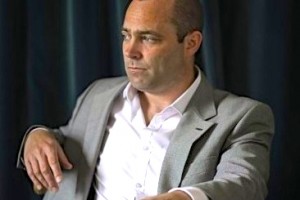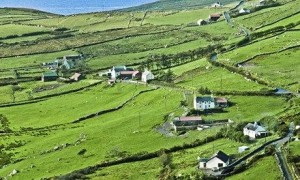Note: This novel was SHORTLISTED for 2013 Irish Book Awards Novel of the Year. Ryan’s previously published novel, The Spinning Heart, was WINNER of the 2012 Irish Book Awards Novel of the Year, and WINNER of the 2013 Guardian First Book Award.
“Loneliness covers the earth like a blanket. It flows in the stream down through the Callows to the lake. It’s in the muck in the yard and the briars in the haggard and the empty outbuildings are bursting with it…When it hits you, it feels like a rap of a hurl across your knuckles on a frosty winter’s morning…[and] no one says sorry for causing it nor asks are you okay, and no kind teacher wants to look at it and tut-tut-and tell you you’ll be grand, good lad.”
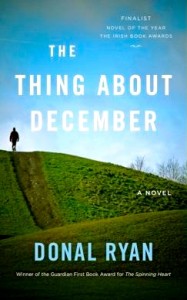 Donal Ryan has had only two of his novels published, yet he has already garnered numerous prestigious awards and encomiums from other admiring writers around the globe. Still in his thirties, he has become so successful in the past two years that in April of this year he was able to leave his public service job with the (Irish) National Rights Authority to devote himself to full-time work as an author. His was not an easy start. The Thing About December and The Spinning Heart, taken together, were rejected forty-seven times before they finally found a publisher with Doubleday Ireland,* and ironically, it was the second of his novels, The Spinning Heart, which was published first, in 2012, with The Thing About December, his first novel, being released the following year. Both of these consummately Irish novels take place in the rural countryside near Limerick, where the author grew up, and both deal with the economic travails of Ireland. In The Spinning Heart, Ryan illustrates the effects on a group of small investors when the “economic bubble” collapses in 2009. In this novel, The Thing About December, set a decade or so earlier, he writes a character novel about that period when the value of real estate skyrocketed and people scrambled to take advantage of the get-rich-quick possibilities involved with buying valuable, undeveloped property – in this novel, the property belonging to Johnsey Cunliffe.
Donal Ryan has had only two of his novels published, yet he has already garnered numerous prestigious awards and encomiums from other admiring writers around the globe. Still in his thirties, he has become so successful in the past two years that in April of this year he was able to leave his public service job with the (Irish) National Rights Authority to devote himself to full-time work as an author. His was not an easy start. The Thing About December and The Spinning Heart, taken together, were rejected forty-seven times before they finally found a publisher with Doubleday Ireland,* and ironically, it was the second of his novels, The Spinning Heart, which was published first, in 2012, with The Thing About December, his first novel, being released the following year. Both of these consummately Irish novels take place in the rural countryside near Limerick, where the author grew up, and both deal with the economic travails of Ireland. In The Spinning Heart, Ryan illustrates the effects on a group of small investors when the “economic bubble” collapses in 2009. In this novel, The Thing About December, set a decade or so earlier, he writes a character novel about that period when the value of real estate skyrocketed and people scrambled to take advantage of the get-rich-quick possibilities involved with buying valuable, undeveloped property – in this novel, the property belonging to Johnsey Cunliffe.
Johnsey, a shy innocent who has adored his strong, assertive da, is devastated by his father’s death from cancer, and when his mother is so hard hit by the death that she herself becomes withdrawn, Johnsey’s minimal support system, such as it was, ceases completely to exist. Always insecure, he often thinks about the past, even as he is bullied unmercifully, before and after school, by Eugene Penrose, “a dole boy,” and some of the other thugs in his school. At one point, he remembers hearing his father say “he was a grand quiet boy to Mother when he thought Johnsey couldn’t hear them talking. Mother must have been giving out about him being a gom and Daddy was defending him. He heard the fondness in Daddy’s voice. But you’d have fondness for an auld eejit of a crossbred pup that should have been drowned at birth,” he thinks. With the death of his mother, his loneliness is total, and even he realizes that “It wasn’t good for [him], the way this house was now. Even a gom like him could see that.” The pastureland on his farm has been leased to Dermot McDermott, and seeing McDermott lording it around on the Cunliffes’ property only adds to Johnsey’s “dead-quiet loneliness” as he copes with the “noisy ignorance” of McDermott and “his fancy farm machinery.”
Scenes appear out of chronological order and gradually convey Johnsey’s past history; at the same time, each chapter represents the weather and activity of successive months of a calendar year. Gradually, the reader’s emotions and sympathies become totally engaged by Johnsey’s story. When he starts working for Packie Collins, who runs a co-op and hates the idea of the minimum wage, Johnsey’s day is stultifying: up in the morning, in to work, lunch in the nearby bakery run by the generous and caring Unthanks, back to work, “get a dog’s abuse on the way home,” try not to cry, home, up to bed, read a book, fall asleep thinking about dad or girls.” At times he visits the slatted barn where his cows stay during the winter, and thinks about throwing a rope over the crossbeam and ending it all, but he is afraid of disappointing the Unthanks, the only people who are kind to him. When they go away for the summer, he is truly alone.
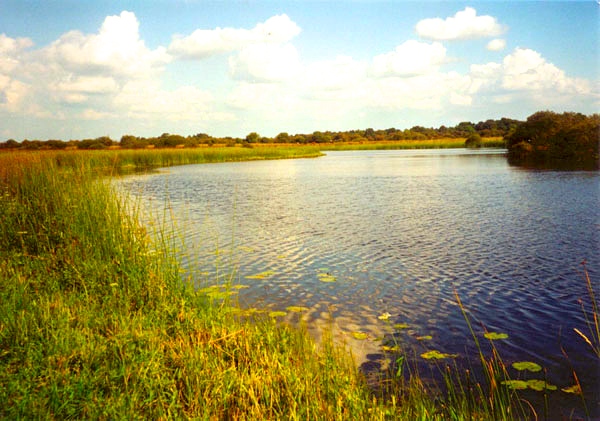
The Callows, beside the River Shannon. “Loneliness covers the earth like a blanket. It flows in the stream down through the Callows to the lake.”
The turning point in the novel begins with Dermot McDermott’s April visit to ask Johnsey to sell him his land, a decision Johnsey cannot bring himself to make because of its family history, but clearly his land has been a major subject of discussion in the community, and the scene is set for a traumatic confrontation over which he has no control. In the aftermath, he comes to know Mumbly Dave and nurse Siobhan, known as Lovely Voice, finding them as close to being his friends as he has ever known. The two chapters in which these three come to know each other provide most of the humor in the novel, however dark it may be. Eventually, Johnsey begins to receive visits from townspeople who suddenly want to be his friend. The press exacerbates the speculation about what may happen to the land in the future, and Johnsey trusts no one.
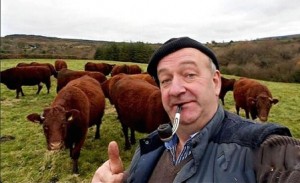
Farmers in rural areas are now using social media to make their lives less lonely. This farmer has posted a “felfie.” Double click to see article in The Guardian about this.
Inexorably, the foreboding increases, as the reader observes Johnsey becoming more and more of a victim, though the question of how much he may be responsible for his own victimization also hangs over all the action. Though the novel is told in the third person, the author conveys Johnsey’s particular point of view and his vernacular to make him become real for the reader, who would have to have a heart of stone not to respond to the problems of this self-described “gom.” When the climax occurs, the parallels between the novel’s “resolution” and the events in Ireland when the real estate “bubble” burst are undeniable. Eventually, this character-based novel becomes for the reader an allegorical representation of a particular time and place from which Ireland and its people will recover, though they will never again be quite so innocent.
*Source: Wikipedia.
ALSO by Donal Ryan: THE SPINNING HEART
Photos, in order: The author’s photo appears on http://ifestboston.com
Irish farmland near Limerick where the author grew up is shown on http://www.theguardian.com/ Photo by Don Klumpp/Getty Images.
The Callows beside the River Shannon: “Loneliness covers the earth like a blanket. It flows in the stream down through the Callows to the lake.” from http://walks.iwai.ie/callows/
Farmer P.J. Ryan of Newport, takes a “felfie,” which is a selfie of a farmer, for social media. See http://www.theguardian.com/ The use of social media is reducing the loneliness of farmers in rural areas. See article.
